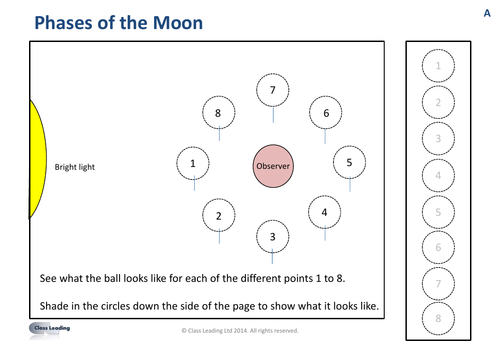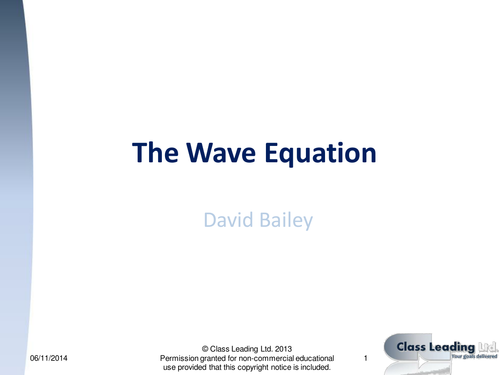314Uploads
262k+Views
194k+Downloads
All resources

Analogue vs. Digital activities
This activity comprises of an interactive spreadsheet model that allows you to change the value in the yellow coloured cell to represent a percentage of noise added to a signal. It allows you to see what happens to both analogue and digital signals with the same amount of noise side by side. There is a worksheet to summarise the difference between the two kinds of signal and also an activity for pupils where they plot out signal plus noise by hand - ideal for a flipped learning (prep) approach where pupils do this in advance of the lesson before discussion in the lesson.

Engaging model of ionic and covalent bonding
Keywords: bonding, model, electrons, ionic, covalent.
Notes: This engaging activity makes use of very affordable and easily available ball pool balls to support whole class teaching and group work. It models what happens to the electrons during ionic and covalent bonding.
Please note that this was originally published a number of years ago as part of the North Yorkshire Success for All project of which I was part and had the pleasure of working with an excellent team of teachers on resource development.
Right click the web links to download the powerpoint shows.

Greenhouse Effect & Solar System - data handling
This activity follows on well from the Greenhouse effect starter. Based on interpreting data about planets in the solar system, it leads learners to the conclusion that Venus is hotter than it should be due to CO2. There are two levels of activity, the more demanding one explores the role of photons/light/radiation in heating planets. This activity was originally designed for 21st Century Science unit P2.
Please note that this is a non-editable resource. A premium editable version is also available at: https://www.tes.com/teaching-resource/resource-11858634
Key words: greenhouse effect, atmosphere, CO2, carbon dioxide, global warming

Electron structure & ionic bonding revision
Keywords: structure, bonding, electron, energy levels, shells, orbitals, rings, periodic table, patterns.
Notes: This is a revision summary sheet that has questions about structure and bonding relating to electron arrangements and ion formation.
Please note that this resource was originally designed for unit C4 of OCR 21st Century Science, but is applicable to other specifications.
It includes an answer sheet.
An editable premium version is available at: https://www.tes.com/teaching-resource/-13142395

Phases of the moon
In this activity, pupils are at the centre of model that shows how the Moon orbits the Earth and how this leads to the phases of the moon appearing. A description of how to do this is shown. A worksheet for recording the appearance of the moon model is included, with answers.
There are also links to a NASA video showing the phases of the moon, the first 30 seconds of which could be used to hook learners. A second video showing the experiment is also linked.
Please ensure that you have carried out a full risk assessment before carrying out any practical activity.

Resistance of LDR & thermistor - graded questions
This activity contains a powerpoint with graded questions & answers and matching pupil activity sheets, designed to be used at the end of a lesson and/or the start of the next lesson to review previous learning. The questions are based on the previous OCR 21st Century Science Specification unit P5, although could be used with other exam boards.
Clicking through the show reveals answers one a time. These reduce to A5 easily, the ideal size for most pupils. Please note grades are approximate.

Work & change of energy - graded questions
This activity contains a powerpoint with graded questions & answers and matching pupil activity sheets, designed to be used at the end of a lesson and/or the start of the next lesson to review previous learning. The questions are based on the previous OCR 21st Century Science Specification unit P4, although could be used with other exam boards.
Clicking through the show reveals answers one a time. These reduce to A5 easily, the ideal size for most pupils. Please note grades are approximate.

Particles - Standard Model Flashcards
These flashcards, when printed out back-to-back and then cut out will produce a series of double sided flashcards showing the composition of particles in the standard model. They are good as an independent learning tool or revision activity. They could be used in preparation for the 'Identify the particle rolling slideshow Instant Engagement / Retrieval - available on TES Resources at:
https://www.tes.com/teaching-resource/resource-6341196

Planning for Progress Lesson Plan
Use this planning template to consolidate and reflect your thinking when planning lessons. The template is focused on supporting progress for all learners.
When using the plan it is suggested that you begin by populating the ‘Expected Learning Outcomes’ section first, then think about how you will find out what they know already and what you have learned. After this, think about the activities that they will do before, during and after the lesson, and finally everything else.
A word document and a pdf version are included.

The Carbon Cycle - Extracting info from a text
Keywords: Carbon cycle, photosynthesis, respiration, decomposition, combustion.
An activity sheet and guidance sheet (with answers highlighted) in which students extract information from a text and then use this to identify the processes in the carbon cycle and ultimately construct a diagram from these. These can then be compared to one published in a textbook to allow students to make corrections. This works exceptionally well as a peer assessed activity.

Eating a sandwich - modelling digestion
There are two parts to this activity, one is a practical activity to model the process of digestion. The other is a powerpoint slideshow to show what happens to the food on its journey through the body. If using with KS3 then the learning outcomes on the activity plan could also include breaking up of molecules in digestion. If using with KS2 for the new curriculum, the powerpoint will include some terms/slides that you may wish to miss out, so it has been left in an editable form.
Please ensure that you carry out a risk assessment before carrying out a practical activity.

Food chains and energy transfer - questions
This is a worksheet based activity that includes some higher order thinking to explore the ideas around energy transfer in simple food chains. Two versions are included, one with legacy GCSE grades, the other without. (please note that grade indications are only approximate). Why not try getting learners to choose a selection of questions to answer (e.g. do Q1-4 or Q3-8) An answer sheet is included.
This resource was originally designed for OCR 21st Century Science unit B3.
A premium editable version of this is available at: https://www.tes.com/teaching-resource/-11858631
Keywords: energy, transfer, food chain, efficiency

Atoms into ions - graded questions
This activity contains a powerpoint with graded questions & answers and matching pupil activity sheets, designed to be used at the end of a lesson and/or the start of the next lesson to review previous learning. The questions are based on the previous OCR 21st Century Science Specification unit C4, although could be used with other exam boards.
Clicking through the show reveals answers one a time. These reduce to A5 easily, the ideal size for most pupils. Please note grades are approximate.

Properties of materials - graded questions
This activity contains a powerpoint with graded questions & answers and matching pupil activity sheets, designed to be used at the end of a lesson and/or the start of the next lesson to review previous learning. The questions are based on the previous OCR 21st Century Science Specification unit C2, although could be used with other exam boards.
Clicking through the show reveals answers one a time. These reduce to A5 easily, the ideal size for most pupils. Please note grades are approximate.

Transformers - graded questions
This activity contains a powerpoint with graded questions & answers and matching pupil activity sheets, designed to be used at the end of a lesson and/or the start of the next lesson to review previous learning. The questions are based on the previous OCR 21st Century Science Specification unit P5, although could be used with other exam boards.
Clicking through the show reveals answers one a time. These reduce to A5 easily, the ideal size for most pupils. Please note grades are approximate.

Potential difference - graded questions
This activity contains a powerpoint with graded questions & answers and matching pupil activity sheets, designed to be used at the end of a lesson and/or the start of the next lesson to review previous learning. The questions are based on the previous OCR 21st Century Science Specification unit P5, although could be used with other exam boards.
Clicking through the show reveals answers one a time. These reduce to A5 easily, the ideal size for most pupils. Please note grades are approximate.

Seismic Waves - graded questions
This activity contains a powerpoint with graded questions & answers and matching pupil activity sheets, designed to be used at the end of a lesson and/or the start of the next lesson to review previous learning. The questions are based on OCR 21st Century Science Specification, although could be used with other exam boards.
Clicking through the show reveals answers one a time. There are two slightly different activity sheets for differentiation - one has key words, the other without. These reduce to A5 easily, the ideal size for most pupils. Please note grades are approximate.

Identify the particle rolling slideshow PP - Instant Engagement / Retrieval
These are a sequence of PowerPoint slideshows designed to support the retrieval of the composition of particles in the standard model. They can be used as an instant engagement task (rolling on screen as students enter the room for immediate engagement with learning). They can also be used as a retrieval quiz. The slideshows are essentially the same task (with rearranged slides) but get progressively more demanding as the changeover of slide gets faster (as the numbers on the titles of the slideshows in brackets increase). Start the students with (1) and then as they get faster, use the more demanding versions.
This resource goes well with the particle flashcards also available on TES Resources at https://www.tes.com/teaching-resource/-6341199

Everyday levers
In this activity pupils can look at the images of levers and think about where the find them and what they do. Either images or real objects (or a combination) can be used with the two sheets, which are differentiated in terms of the number of expected responses and the questions used. Please note that clock (a 'distance multiplier&') is different to the other levers shown (&';force multipliers') and spotting the odd one out and providing a reason gives an extension for more able pupils. Please ensure that you have carried out a full risk assessment before carrying out any practical activity.

The Wave Equation - graded questions
This activity contains a powerpoint with graded questions & answers and matching pupil activity sheets, designed to be used at the end of a lesson and/or the start of the next lesson to review previous learning. The questions are based on OCR 21st Century Science Specification, although could be used with other exam boards.
Clicking through the show reveals answers one a time. There are two slightly different activity sheets for differentiation - one has key words, the other without. These reduce to A5 easily, the ideal size for most pupils. Please note grades are approximate.




















